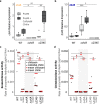Chitin degradation by Synechococcus WH7803
- PMID: 37968300
- PMCID: PMC10651935
- DOI: 10.1038/s41598-023-47332-0
Chitin degradation by Synechococcus WH7803
Abstract
Chitin is an abundant, carbon-rich polymer in the marine environment. Chitinase activity has been detected in spent media of Synechococcus WH7803 cultures-yet it was unclear which specific enzymes were involved. Here we delivered a CRISPR tool into the cells via electroporation to generate loss-of-function mutants of putative candidates and identified ChiA as the enzyme required for the activity detected in the wild type.
© 2023. The Author(s).
Conflict of interest statement
The authors declare no competing interests.
Figures


References
MeSH terms
Substances
LinkOut - more resources
Full Text Sources

